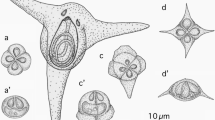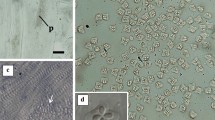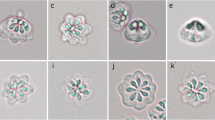Abstract
Purpose
Myxosporeans of the genera Kudoa and Unicapsula (Cnidaria: Myxozoa: Myxosporea: Multivalvulida) may be causative agents of diseases that substantially lower the commercial value of certain marine fishes; thus, species identification is important to effectively manage outbreaks and control infections.
Methods and Results
Our investigations of commercial fishes in the families Leiognathidae (three species), Ambassidae (one), Carangidae (five) and Gerreidae (one) in the South China Sea revealed new host records for Kudoa lutjanus (Ambassis martanus, and Gerres limbattus), Kudoa trachuri (Decapterus maruadsi, and Decapterus macrosoma), Kudoa uncinata (Photopectoralis bindus), and Kudoa longichorda (D. macrosoma) and new geographical distribution records for Kudoa javanensis (Alepes djedaba), K. trachuri, and K. longichorda. Moreover, three new Kudoa spp. were described based on detected specimens forming pseudocysts in trunk muscle myofibres. These included Kudoa corniculata n. sp. from Eubleekeria jonesi, and Leiognathus equulus; Kudoa hirsuta n. sp. from Trachurus japonicas, D. maruadsi, and D. macrosoma; and Kudoa parvibulvosa n. sp. from Megalaspis cordyla. To identify these species, their myxospores were morphologically and molecularly characterised based on the small and large subunits of their ribosomal RNA genes.
Conclusions
In this study, we demonstrated morphometric variations in the myxospores of various species and an atypical K. uncinata morphotype with unequal polar capsules. Hence, taxonomic identification of myxosporeans require molecular characterisation.






Similar content being viewed by others
Availability of Data and Materials
Myxosporean specimens collected for this study were deposited in the Meguro Parasitological Museum, Tokyo, Japan, under collection nos. 21659–21663, 21665–21701, and 21703. The nucleotide sequences obtained in this study are available from the DDBJ/EMBL/GenBank databases under the accession nos. LC569705–LC569721 (host fish cox-1), and LC626058–LC626079 (parasite rDNA). The data that support the findings of this study are available from the corresponding author upon reasonable request.
References
Fiala I, Bartošová-Sojková P, Whipps CM (2015) Classification and phylogenetics of Myxozoa. In: Okamura B, Gruhl A, Bartholomew JL (eds) Myxozoan evolution, ecology and development. Springer International Publishing AG, Cham, Switzerland, pp 85–110
Atkinson SD, Bartholomew JL, Lotan T (2018) Myxozoans: ancient metazoan parasites find a home in phylum Cnidaria. Zoology 129:66–68. https://doi.org/10.1016/j.zool.2018.06.005
Yahalomi D, Atkinson SD, Neuhof M, Chang ES, Philippe H, Cartwright P, Bartholomew JL, Huchon D (2020) A cnidarian parasite of salmon (Myxozoa: Henneguya) lacks a mitochondrial genome. Proc Natl Acad Sci USA 117:5358–5363. https://doi.org/10.1073/pnas.1909907117
Egusa S, Nakajima K (1980) Kudoa amamiensis n. sp. (Myxosporea: Multivalvulida) found in cultured yellowtails and wild damselfishes from Amami-Ohshima and Okinawa, Japan. Bull Jpn Soc Sci Fish 46:1193–1198
Sugiyama A, Yokoyama H, Ogawa K (1999) Epizootiological investigation on kudoosis amami caused by Kudoa amamiensis (Multivalvulida: Myxozoa) in Okinawa Prefecture, Japan. Fish Pathol 34:39–43. https://doi.org/10.3147/JSFP.34.39
Hartikainen H, Bass D, Briscoe AG, Knipe H, Green AJ, Okamura B (2016) Assessing myxozoan presence and diversity using environmental DNA. Int J Parasitol 46:781–792. https://doi.org/10.1016/j.ijpara.2016.07.006
Lom J, Dyková I (2006) Myxozoan genera: definition and notes on taxonomy, life-cycle terminology and pathogenic species. Folia Parasitol 53:1–36. https://doi.org/10.14411/fp.2006.001
Whipps CM, Adlard RD, Bryant MS, Kent ML (2003) Two unusual myxozoans, Kudoa quadricornis n. sp. (Multivalvulida) from the muscle of goldspotted trevally (Carangoides fulvoguttatus) and Kudoa permulticapsula n. sp. (Multivalvulida) from the muscle of Spanish mackerel (Scomberomorus commerson) from the Great Barrier Reef, Australia. J Parasitol 89:168–173. https://doi.org/10.1645/0022-3395(2003)089[0168:TUMKQN]2.0.CO;2
Whipps CM, Grossel G, Adlard RD, Yokoyama H, Bryant MS, Munday BL, Kent ML (2004) Phylogeny of the Multivalvulidae (Myxozoa: Myxosporea) based on comparative ribosomal DNA sequence analysis. J Parasitol 90:618–622. https://doi.org/10.1645/GE-153R
Moran JDW, Whitaker DJ, Kent ML (1999) A review of the myxosporean genus Kudoa Meglitsch, 1947, and its impact on the international aquaculture industry and commercial fisheries. Aquaculture 172:163–196. https://doi.org/10.1016/S0044-8486(98)00437-2
Eiras JC, Saraiva A, Cruz C (2014) Synopsis of the species of Kudoa Meglitsch, 1947 (Myxozoa: Myxosporea: Multivalvulida). Syst Parasitol 87:153–180. https://doi.org/10.1007/s11230-013-9461-4
Sato H, Kasai A (2016) Kudoa species (Myxozoa: Myxosporea: Multivalvulida) recorded in Japan or its surrounding natural waters (1930–2016). Jpn J Vet Parasitol 15:111–138 (in Japanese with English summary)
Kasai A, Setsuda A, Sato H (2017) Morphological and genetic characterization of Kudoa whippsi (Myxosporea: Multivalvulida) from Cheilodactylus zonatus in the western Pacific Ocean off Japan, and two new Kudoa spp. (K. akihitoi n. sp. and K. empressmichikoae n. sp.) from Acanthogobius hasta in the Sea of Ariake, Japan. Parasitol Res 116:647–659. https://doi.org/10.1007/s00436-016-5329-2
Abdel-Baki AS, Abdel-Haleem HM, Al-Quraishy S, Azevedo C, Mansour L (2018) Ultrastructural and molecular characteristics of Kudoa crenimugilis n. sp. infecting intestinal smooth muscle of fringelip mullet Creninmugil crenilabis in the Red Sea. Dis Aquat Org 129:53–62. https://doi.org/10.3354/dao03225
Özer A, Okkay S, Gürkanli CT, Çiftçi Y, Yurankhno V (2018) Two novel myxosporean parasites in Black Sea fishes: Kudoa niluferi sp. nov. and Kudoa anatolica sp. nov. (Cnidaria: Myxospoea). Dis Aquat Org 128:225–233. https://doi.org/10.3354/dao03227
Sakai H, Kato E, Sakaguchi S, Setsuda A, Sato H (2018) Morphological and molecular genetic characterization of Kudoa konishiae n. sp. (Myxosporea: Multivalvulida) in the muscle of Japanese Spanish mackerel (Scomberomorus niphonius). Parasitol Res 117:893–904. https://doi.org/10.1007/s00436-018-5770-5
Sakai H, Kawai T, Zhang J, Sato H (2019) New host records of three Kudoa spp. (K. yasunagai, K. thalassomi, and K. igami) with notable variation in the number of shell valves and polar capsules in spores. Parasitol Res 118:143–157. https://doi.org/10.1007/s00436-018-6144-8
Casal G, Soares EC, Rocha S, Silva TJ, Santos EL, Nascimento R, Oliveira E, Zaevedo C (2019) Description of a new myxozoan Kudoa eugerres n. sp. and reclassification of two Sphaerospora sensu lato species. Parasitol Res 118:1719–1730. https://doi.org/10.1007/s00436-019-06324-8
Monteiro EP, Da Silva DT, Hamoy I, Sanches O, Matos E (2019) Morphological and molecular characteristics of Kudoa viseuensis n. sp. (Myxosporea: Multivalvulida), found in the muscle of Batrachoides surinamensis (Teleostei: Batrachoididae) in the Brazilian Amazon Region. Acta Protozool 58:7–16. https://doi.org/10.4467/16890027AP.19.002.10833
Li Y-C, Tamemasa S, Zhang J-Y, Sato H (2020) Phylogenetic relationships of three Kudoa spp. with morphologically similar myxospores (K. iwatai, K. lutjanus, and K. bora), with the redescription of K. uncinata and K. petala and description of a new species (K. fujitai n. sp.) in fishes in the South China Sea. Parasitol Res 119:1221–1236. https://doi.org/10.1007/s00436-020-06636-0
Li Y-C, Inoue K, Tanaka S, Zhang J-Y, Sato H (2020) Identification of four new Kudoa spp. (Myxozoa: Myxosporea: Multivalvulida) in commercial fishes collected from South China Sea, Atlantic Ocean, and Bering Sea by integrated taxonomic approach. Parasitol Res 119:2113–2128. https://doi.org/10.1007/s00436-020-06707-2
Yunus M, Yustinasari LR, Natalia D, Ghosh S, Sakuma K, Inoue K, Sato H (2021) First report of three multivalvulid species (Cnidaria: Myxozoa: Myxosporea) in commercial fishes from Java Sea, Indonesia, with records of Unicapsula pyramidata and two new Kudoa spp. Parasitol Res 120:861–876. https://doi.org/10.1007/s00436-020-07030-6
Hervio DML, Khattra J, Devlin RH, Kent ML, Sakanari J, Yokoyama H (1997) Taxonomy of Kudoa species (Myxosporea), using a small-subunit ribosomal DNA sequence. Can J Zool 75:2112–2119. https://doi.org/10.1139/Z97-846
Atkinson SD, Bartošová-Sojková P, Whipps CM, Bartholomew JL (2015) Approaches for characterising myxozoan species. In: Okamura B, Gruhl A, Bartholomew JL (eds) Myxozoan evolution, ecology and development. Springer International Publishing AG, Cham, Switzerland, pp 111–123
Shul’man SS (1966) Myxosporidia of the USSR. Nauka Publishers, Moscow (English book translated from Russian, Amerind Publishing, New Delhi, India, in 1988)
Egusa S (1986) The order Multivalvulida Shulman, 1959 (Myxozoa: Myxosporea): a review. Fish Pathol 21:261–274 (in Japanese with English summary)
Chen C, Ma C (1998) Fauna Sinica: Myxozoa, Myxosporea. Science Press, Beijing, China (in Chinese)
Li Y-C, Tamemasa S, Zhang J-Y, Sato H (2020) Phylogenetic characterisation of seven Unicapsula spp. (Myxozoa: Myxosporea: Multivalvulida) from commercial fish in southern China and Japan. Parasitology 147:448–464. https://doi.org/10.1017/S0031182019001793
Inoue K, Li Y-C, Ghosh S, Yunus M, Zhang J-Y, Sato H (2021) Identification of a new species, Unicapsula aequilobata n. sp., and Unicapsula seriolae (Myxozoa: Myxosporea: Multivalvulida) in carangid fish from the South China Sea. Parasitol Res 120:2379–2389. https://doi.org/10.1007/s00436-021-07108-9
Ward RD, Zemlak TS, Innes BH, Last PR, Hebert DN (2005) DNA barcoding Australia’s fish species. Philos Trans R Soc B Biol Sci 360:1847–1857. https://doi.org/10.1098/rstb.2005.1716
Zhang JB, Hanner R (2011) DNA barcoding is a useful tool for the identification of marine fishes from Japan. Biochem Syst Ecol 39:31–42. https://doi.org/10.1016/j.bse.2010.12.017
Lom J, Arthur JR (1989) A guideline for the preparation of species descriptions in Myxosporea. J Fish Dis 12:151–156. https://doi.org/10.1111/j.1365-2761.1989.tb00287.x
Parker JD, Warner MC (1970) Effects of fixation, dehydration and staining on dimensions of myxosporidian and microsporidian spores. J Wildl Dis 6:448–456. https://doi.org/10.7589/0090-3558-6.4.448
Matsukane Y, Sato H, Tanaka S, Kamata Y, Sugita-Konishi Y (2011) Kudoa iwatai and two novel Kudoa spp., K. trachuri n. sp. and K. thunni n. sp. (Myxosporea: Multivalvulida), from daily consumed marine fish in western Japan. Parasitol Res 108:913–926. https://doi.org/10.1007/s00436-010-2133-2
Li Y-C, Sato H, Tanaka S, Ohnishi T, Kamata Y, Sugita-Konishi Y (2013) Characterization of the ribosomal RNA gene of Kudoa neothunni (Myxosporea: Multivalvulida) in tunas (Thunnus spp.) and Kudoa scomberi n. sp. in a chub mackerel (Scomber japonicus). Parasitol Res 112:1991–2003. https://doi.org/10.1007/s00436-013-3357-8
Kasai A, Li Y-C, Setsuda A, Mafie E, Sato H (2015) Genetic characterization of Kudoa iwatai and Kudoa trachuri in commercial marine fish (Platycephalus sp. and Trachurus japonicus) for human consumption. Jpn J Vet Parasitol 14:22–30
Hallett SL, Diamant A (2001) Ultrastructure and small subunit ribosomal DNA sequence of Henneguya lesteri n. sp. (Myxosporea), a parasite of sand whiting Sillago analis (Sillaginidae) from the coast of Queensland, Australia. Dis Aquat Org 46:197–212. https://doi.org/10.3354/dao046197
Fiala I (2006) The phylogeny of Myxosporea (Myxozoa) based on small subunit ribosomal RNA gene analysis. Int J Parasitol 36:1521–1534. https://doi.org/10.1016/j.ijpara.2006.06.016
Kato E, Kasai A, Tomochi H, Li Y-C, Sato H (2017) Four Myxobolus spp. (Myxosporea: Bivalvulida) from the gill lamellae of common carp (Cyprinus carpio) and Japanese silver crucian carp (Carassius langsdorfii) in the western part of Japan, with the description of three new species (M. tanakai n. sp., M. paratoyamai n. sp., and M. ginbuna n. sp.). Parasitol Res 116:2427–2441. https://doi.org/10.1007/s00436-017-5545-4
Freeman MA, Yokoyama H, Ogawa K (2008) Description and phylogeny of Ceratomyxa anko sp. n. and Zschokkella lophii sp. n. from the Japanese anglerfish, Lophius litulon (Jordan). J Fish Dis 31:921–930. https://doi.org/10.1111/j.1365-2761.2008.00965.x
Kumar S, Stecher G, Tamura K (2016) MEGA7: molecular evolutionary genetics analysis version 7.0 for bigger datasets. Mol Biol Evol 33:1870–1874. https://doi.org/10.1093/molbev/msw054
Guindon S, Gascuel O (2003) A simple, fast, and accurate algorithm to estimate large phylogenies by maximum likelihood. Syst Biol 52:696–704. https://doi.org/10.1080/10635150390235520
Dereeper A, Guignon V, Blanc G, Audic S, Buffet S, Chevenet F, Dufayard JF, Guindon S, Lefort V, Lescot M, Claverie J-M, Gascuel O (2008) Phylogeny.fr: robust phylogenetic analysis for the non-specialist. Nucleic Acid Res 36:465–469. https://doi.org/10.1093/nar/gkn180
Anisimova M, Gascuel O (2006) Approximate likelihood-ratio test for branches: a fast, accurate, and powerful alternative. Syst Biol 55:539–552. https://doi.org/10.1080/10635150600755453
Wang P-C, Huang J-P, Tsai M-A, Cheng S-Y, Tsai S-S, Chen S-D, Chen S-P, Chui S-H, Liaw L-L, Chang L-T, Chen S-C (2005) Systemic infection of Kudoa lutjanus n. sp. (Myxozoa: Myxosporea) in red snapper Lutjanus erythropterus from Taiwan. Dis Aquat Org 67:115–124. https://doi.org/10.3354/dao067115
Egusa S, Shiomitsu T (1983) Two new species of the genus Kudoa (Myxosporea: Multivalvulida) from marine cultured fishes in Japan. Fish Pathol 18:163–171 (in Japanese with English summary)
Diamant A, Ucko M, Paperna I, Colorni A, Lipshitz A (2005) Kudoa iwatai (Myxosporea: Multivalvulida) in wild and cultured fish in the Red Sea: redescription and molecular phylogeny. J Parasitol 91:1175–1189. https://doi.org/10.1645/GE-491R.1
Abe N, Maehara T, Kashino M, Ohyama M (2011) Identification of parasites found in fresh fish by morphological and sequencing analyses. Annu Rep Osaka City Inst Pub Health Environ Sci 73:29–37 (in Japanese with English summary)
Inoue K, Kasai A, Argamjav B, Sato H (2022) Four carangid fish species as new host records for Kudoa trachuri (Myxozoa: Myxosporea: Multivalvulida), and description of a new species, Kudoa longichorda n. sp., forming pseudocysts in the muscle of Decapterus tabl. Folia Parasitol (in press)
Zhou Y, Zhao Y-J (2008) Description of three new species of Kudoa (Myxosporea, Multivalvulida, Kudoiae) parasitic in marine fishes from the East China Sea. Acta Hydrobiol Sin 32(Suppl):51–56 (in Chinese with English summary)
Kovaleva AA, Gaevskaya AV (1983) [First data on fish myxosporidia of the southeastern Pacific open waters.] Vestnik Zool 17:6–11 (in Russian)
Pampoulie C, Marques A, Rosecchi E, Crivelli AJ, Bouchereau J-L (1999) A new myxosporean parasite, Kudoa camarguensis n. sp., recorded on two goby species (Teleostei: Pisces) in the Rhône Delta (Mediterranean Sea, France). J Eukaryot Microbiol 46:304–310
Dyková I, de Buron I, Fiala I, Roumillat WA (2009) Kudoa inornata sp. n. (Myxosporea: Multivalvulida) from the skeletal muscles of Cynoscion nebulosus (Teleostei: Sciaenidae). Folia Parasitol 56:91–98
Pascual S, Abollo E, Yurakhno V, Gaevskaya A (2012) Molecular characterization of Kudoa nova (Myxosporea: Multivalvulida) infecting the round goby Neogobius melanostomus from the Sea of Azov. [Mar Ecol J] 11:66–73
Burger MAA, Adlard RD (2011) Low host specificity in the Kudoidae (Myxosporea: Multivalvulida) including seventeen new host records for Kudoa thalassomi. Folia Parasitol 58:1–16. https://doi.org/10.14411/fp.2011.001
Burger MAA, Adlard RD (2010) Phenotypic variation in a significant spore character in Kudoa (Myxosporea: Multivalvulida) species infecting brain tissue. Parasitology 137:1759–1772. https://doi.org/10.1017/S0031182010000673
Matsukane Y, Sato H, Tanaka S, Kamata Y, Sugita-Konishi Y (2010) Kudoa septempunctata n. sp. (Myxosporea: Multivalvulida) from an aquacultured olive flounder (Paralichthys olivaceus) imported from Korea. Parasitol Res 107:865–872. https://doi.org/10.1007/s00436-010-1941-8
Kasai A, Li Y-C, Mafie E, Sato H (2016) New host records of monacanthid fish for three Kudoa spp. (K. septempunctata, K. thyrsites, and K. shiomitsui) prevalent in the olive flounder (Paralichthys olivaceus), with the description of K. parathyrsites n. sp. from a black scraper (Thamnaconus modestus). Parasitol Res 115:2741–2755. https://doi.org/10.1007/s00436-016-5023-4
Yokoyama H, Mekata T, Satoh J, Nishioka T, Mori K (2017) Morphological and molecular comparisons between Japanese and Korean Isolates of Kudoa septempunctata (Myxozoa: Multivalvulida) in the olive flounder Paralichthys olivaceus. Fish Pathol 52:152–157. https://doi.org/10.3147/jsfp.52.152
Burger MAA, Adlard RD (2010) Four new species of Kudoa Meglitsch, 1947 (Myxosporea: Multivalvulida) from Australia with recommendations for species descriptions in the Kudoidae. Parasitology 137:793–814. https://doi.org/10.1017/S0031182009991557
Kasai A, Tsuduki H, Jimenez LA, Li Y-C, Tanaka S, Sato H (2017) Incidence of three Kudoa spp., K. neothunni, K. hexapunctata, and K. thunni (Myxosporea: Multivalvulida), in Thunnus tunas distributed in the western Pacific Ocean. Parasitol Res 116:1137–1150. https://doi.org/10.1007/s00436-016-5369-7
Inoue K, Kasai A, Argamjav B, Sato H (2021) Occurrence of Kudoa prunusi and Kudoa lateolabracis (Myxozoa: Myxosporea: Multivalvulida) in Philippine-Sea Japanese parrotfish (Calotomus japonicus). Parasitol Res 121:601–612. https://doi.org/10.1007/s00436-021-07418-y
Okamura B, Hartigan A, Naldoni J (2018) Extensive uncharted biodiversity: the parasite dimension. Integr Comp Biol 58:1132–1145. https://doi.org/10.1093/icb/icy039
Zhang Z-Q (2013) Animal biodiversity: an update of classification and diversity in 2013. Zootaxa 3703:1–11. https://doi.org/10.11646/zootaxa.3703.1.3
Hendrickson GL, Carleton A, Manzer D (1989) Geographic and seasonal distribution of the infective stage of Ceratomyxa shasta (Myxozoa) in northern California. Dis Aquat Org 7:165–169. https://doi.org/10.3354/dao007165
Sekiya M, Setsuda A, Sato H, Song K, Han J-K, Kim G-J, Yeo IK (2016) Enteromyxum leei (Myxosporea: Bivalvulida) as the cause of myxosporean emaciation disease of farmed olive flounders (Paralichthys olivaceus) and a turbot (Scophthalmus maximus) on Jeju Island, Korea. Parasitol Res 115:4229–4237. https://doi.org/10.1007/s00436-016-5200-5
Katharios P, Varvarigos P, Keklikoglou K, Ruetten M, Sojan J, Akter M, Cascarano MC, Tsertou MI, Kokkari C (2020) Native parasite affecting an introduced host in aquaculture: cardiac henneguyosis in the red seabream Pagrus major Temminck & Schlegel (Perciformes: Sparidae) caused by Henneguya aegea n. sp. (Myxosporea: Myxobolidae). Parasit Vectors 13:27. https://doi.org/10.1186/s13071-020-3888-7
Yokoyama H, Whipps CM, Kent ML, Mizuno K, Kawakami H (2004) Kudoa thyrsites from Japanese flounder and Kudoa lateolabracis n. sp. from Chinese Sea bass: causative myxozoans of post-mortem myoliquefaction. Fish Pathol 39:79–85. https://doi.org/10.3147/jsfp.39.79
Yokoyama H, Itoh N (2005) Two multivalvulid myxozoans causing postmortem myoliquefaction: Kudoa megacapsula n. sp. from red barracuda (Sphyraena pinguis) and Kudoa thyrsites from splendid alfonso (Beryx splendens). J Parasitol 91:1132–1137. https://doi.org/10.1645/GE-548R.1
Yokoyama H, Yanagida T, Takemaru I (2006) The first record of Kudoa megacapsula (Myxozoa: Multivalvulida) from farmed yellowtail Seriola quinqueradiata originating from wild seedlings in South Korea. Fish Pathol 41:159–163. https://doi.org/10.3147/jsfp.41.159
Acknowledgements
This study was partially supported by a Grant-in-Aid for Young Ph.D. Researcher (No: R17022) from the Faculty of Agricultural Science, Guangdong Ocean University (YCL); Grant-in-Aid for Food Science and Research 2019 from The TOYO SUISAN FOUNDATION (HS); Grant-in-Aid for International Collaboration Research 2019 from the Goho Life Sciences International Fund 2019 (JYZ); and the Japan Society for the Promotion of Science (JSPS) KAKENHI grant number 18K05995 (HS).
Author information
Authors and Affiliations
Contributions
Not applicable.
Corresponding author
Ethics declarations
Conflict of Interest
The authors declare that they have no conflict of interest.
Ethics Approval
Not applicable.
Consent to Participate
Not applicable.
Consent for Publication
Not applicable.
Additional information
Publisher's Note
Springer Nature remains neutral with regard to jurisdictional claims in published maps and institutional affiliations.
Supplementary Information
Below is the link to the electronic supplementary material.
Rights and permissions
About this article
Cite this article
Li, YC., Inoue, K., Zhang, JY. et al. Descriptions of Three New Species and New Host or Distribution Records of Five Species of the Genus Kudoa (Myxozoa: Myxosporea: Multivalvulida) in Commercial Fishes Collected from South China Sea. Acta Parasit. 67, 976–996 (2022). https://doi.org/10.1007/s11686-022-00545-1
Received:
Accepted:
Published:
Issue Date:
DOI: https://doi.org/10.1007/s11686-022-00545-1




